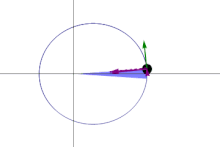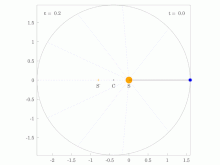| Areal velocity | |
|---|---|
 Areal velocity is the area swept out per unit time by the position vector (w.r.t. a reference point A) of a particle moving along a curve da/dt=const (shown in blue) | |
Other names | Areal speed |
| SI unit | m2/s |
| Dimension | L2 T−1 |
In classical mechanics, areal velocity (also called sector velocity or sectorial velocity) is a pseudovector whose length equals the rate of change at which area is swept out by a particle as it moves along a curve. It has SI units of square meters per second (m2/s) and dimension of square length per time L2 T−1.
Contents
- Relationship with angular momentum
- Derivation of the connection with angular momentum
- Relationship with magnetic dipoles
- See also
- References
- Further reading
In the adjoining figure, suppose that a particle moves along the blue curve. At a certain time t, the particle is located at point B, and a short while later, at time t + Δt, the particle has moved to point C. The region swept out by the particle is shaded in green in the figure, bounded by the line segments AB and AC and the curve along which the particle moves. The areal velocity magnitude (i.e., the areal speed ) is this region's area divided by the time interval Δt in the limit that Δt becomes vanishingly small. The vector direction is postulated to be normal to the plane containing the position and velocity vectors of the particle, following a convention known as the right hand rule.
Conservation of areal velocity is a general property of central force motion, [1] and, within the context of classical mechanics, is equivalent to the conservation of angular momentum.












